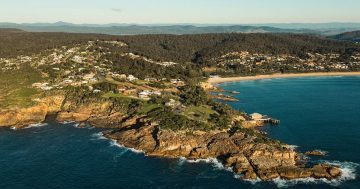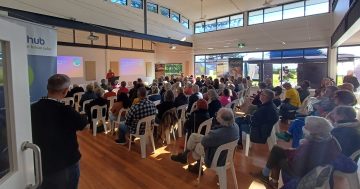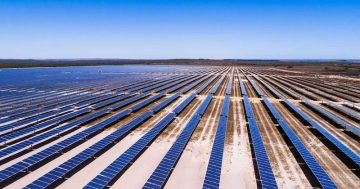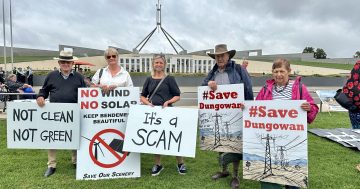
250 people packed into the Tathra Primary School hall for the meeting called by Clean Energy for Eternity. Photo: Ian Campbell.
The Bega Valley has taken its first step towards being powered by 100% renewable energy by 2030.
Last night’s public meeting in Tathra unanimously endorsed the idea, the only dissenting voice was that of Brogo’s Peter Haggar who with a smile suggested 2025 should be the target. An academic from the Australian National University said that is very possible.
Answering the call from local climate change action group Clean Energy for Eternity (CEFE), 250 people packed into the Tathra Primary School hall. It was the first in a series of meetings CEFE is planning, in order to bring broad community agreement to their green power ambition. The next meeting will be held at the Bega Civic Centre on March 19.
“People are searching for leadership on climate change,” CEFE Founder, Dr Matthew Nott said.
“But in particular, regional areas appreciate the huge economic opportunity.”
The meeting heard from a range of speakers – Bega Valley Mayor, Kristy McBain, President of the Merimbula Chamber of Commerce, Lynn McColl, Professor Andrew Blakers, Director of the Centre for Sustainable Energy Systems at the Australian National University (ANU), Martin Poole, Chief Executive Officer, Epuron and former Federal Liberal Leader, Dr John Hewson.
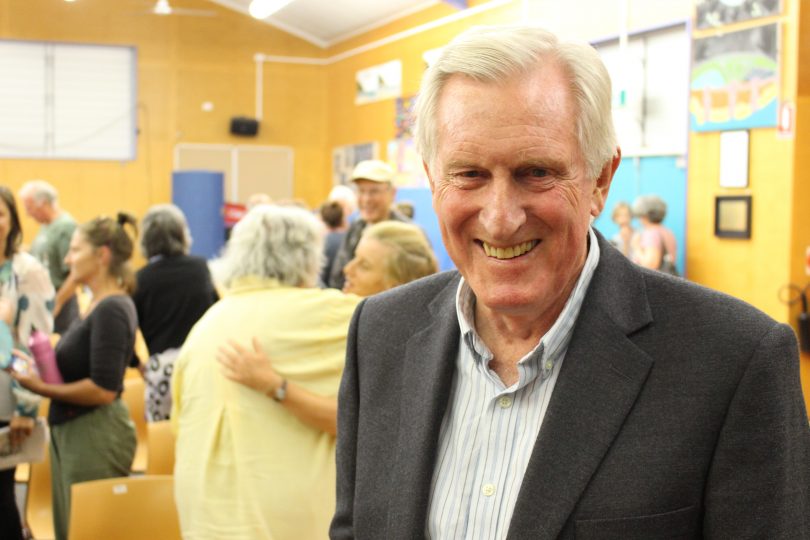
Dr John Hewson. Photo: Ian Campbell
All spoke with enthusiastic support of the 100% by 2030 push and offered ideas for how it could be done.
“It’s good to be here, at the cutting edge of the debate, communities around Australia are leading the way,” Dr Hewson said.
“It is smart politics to recognise the inevitability of the transition to a low carbon society and the fundamental role of renewables in that transition.
“So wouldn’t you think that in politics you’d be smart enough to recognise that and get on with it?
“I wasn’t much of a politician, but if 70 to 80% of the electorate believe we should be doing something, you should listen to them.”
Dr Hewson despairs at the politics that has left the development of renewables to the market and the community.
“In the thirty years that I have been involved in this issue, we still don’t have a national energy policy, a climate action strategy, or an emissions reduction strategy,” he said.
“A government that does not have a climate action plan forfeits its right to govern.
“The nature of the game that is being played is point scoring and blame shifting rather than dealing with the problem,” he said.
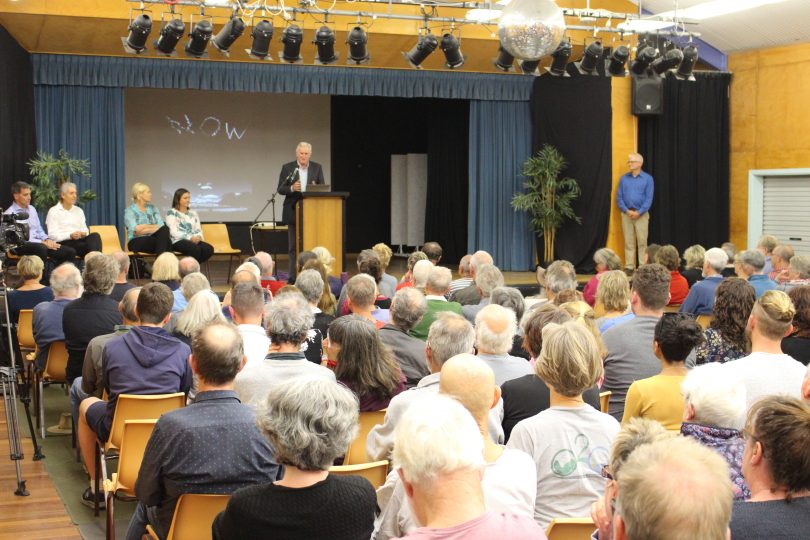
“A government that does not have a climate action plan forfeits its right to govern.” – Dr John Hewson. Photo: Ian Campbell.
The presence the former would be Prime Minister brought to the meeting energised those within CEFE and the local community who have been actively campaigning on the issue since 2006. However, it was Professor Andrew Blackers from ANU that captivated and surprised many.
“I’ve got some good news,” Prof Blakers said.
“Eighty-five percent of all greenhouse gas emissions are caused by oil, gas and coal.
“Renewable energy truly is the only fast and effective way [of reducing emmissions].”
Prof Blakers believes that the economics around renewable energy is driving growth in the sector, independent of government inaction and medaling.
“Wind and solar dominate the global deployment of energy and Australia is the global renewable energy superstar,” he said.
“In terms of watts per person per year, Australia is currently installing four to five times as much wind and solar as the EU, the USA, Japan, or China – we are double the next best, Uruguay.
“In 2018 we [Australia] had twenty-one percent renewable energy and that is increasing at half a percent per month, so at the end of this year it will be at twenty-six percent.”
Prof Blakers says the increasing affordability of wind and solar makes the switch to renewables, “so compelling.”
“Solar and wind are now cheaper than existing gas power stations, cheaper than new build gas and coal power stations – and competitive with the operating costs of existing black coal power stations.
“I think most of them [coal and gas power stations] will close by 2030 because they can not compete with wind and solar.”
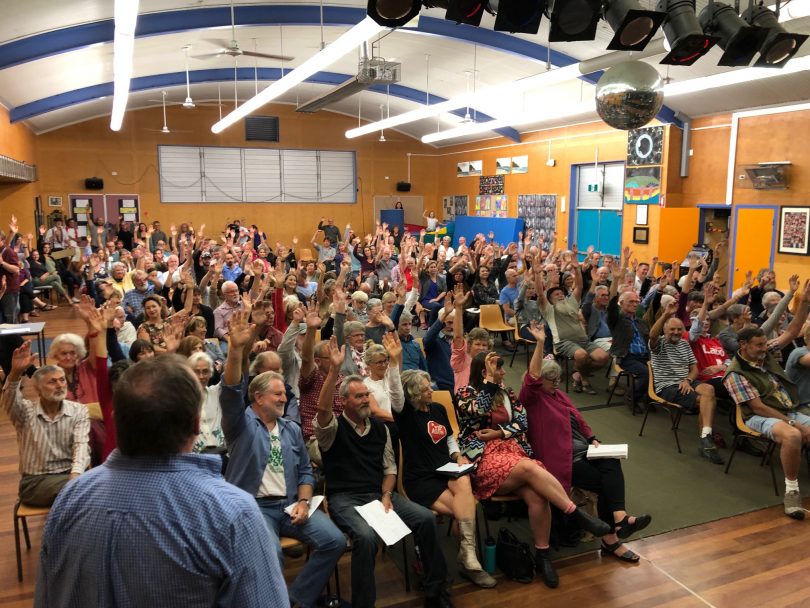
Tathra votes for 100% by 2030. Photo: Ian Campbell.
Prof Blakers suggests political agendas and self-interest have slowed what could be faster growth in the renewable energy sector.
“Even in the hostile framework we are operating in at the moment we are still putting in six-plus gigawatts [of renewable energy] each year, the commercial imperative is so compelling and will get even more compelling,” he said.
Aside from the Bega Valley’s solar potential, when it comes to achieving the 100% by 2030 ambition, Prof Blackers points to dozens of sites along the coastal escarpment that the ANU has flagged as having pumped hydroelectricity potential – similar to Snowy 2.0.
“There are a lot of really good sites around Cathcart and Brown Mountain,” he said.
Martin Poole, Chief Executive Officer, of renewable energy company Epuron outlined a number of investment models to fund the development of large scale power generation, involving private, government and community raised money.
“There are examples out there, a lot of lessons have been learnt, so don’t go and reinvent the wheel,” he advised.
“There are some innovative new retailers out there, they have a commercial structure where they install the solar system and people can buy into it afterwards.
“If you can’t fund it or you can’t get someone else to fund it – it won’t happen. Tackle that first.”

“People are searching for leadership on climate change.” – CEFE Founder, Dr Matthew Nott. Photo: Ian Campbell.
Tathra’s support for 100% by 2030 will be written across the town’s water tower on Saturday, signalling a commitment to community lead action on climate change and economic development.
It’s a discussion the whole Bega Valley will soon be involved with, ramping up the interest and expectations around policy initiatives in the run-up to the NSW Election on March 23 and the Federal Election some time in May. Those gathered at Tathra last night are clear about what will win their vote.







